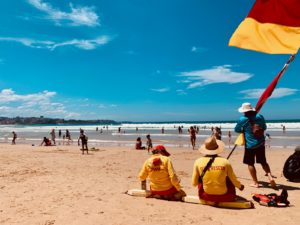 For many people, there is nothing like a day at the beach. The sun is out, the water is inviting, and being at the beach means a day away from the stresses of everyday life. Of course, it doesn’t need to be sunny for you to visit the beach.
For many people, there is nothing like a day at the beach. The sun is out, the water is inviting, and being at the beach means a day away from the stresses of everyday life. Of course, it doesn’t need to be sunny for you to visit the beach.
But, regardless of the weather, you need to be aware of the most common beach hazards. This will allow you to be prepared to avoid them.
You should note that the most common perceived hazards are:
- Rip currents
- Marine stingers
- Sun exposure
- Sharks
- Crocodiles
- Rocks
- Waves
These are the perceived hazards which is why you need to be particularly aware of the following:
Rip Currents
The biggest perceived threat when you enter the water is a rip current, 80% of Australians consider it the biggest hazard. This is a current of water that is virtually invisible from above the water. It is very powerful and carries things away from the shore. If you get caught in a rip you can quickly find yourself a long way out to sea.
To protect yourself against this hazard look for beaches that have surf lifesavers and the standard flag system. You should swim between the red and yellow flags as this reduces the likelihood of you getting caught in a rip current.
While it doesn’t remove the hazard, if you support Surf Life Saving Foundation you will be helping to ensure there are surf lifesavers and warnings on all appropriate beaches.
Drowning
The SLSA National Coastal Safety Report showed 136 coastal drowning deaths in 2020, that’s a sobering fact. While even the strongest of swimmers can drown, it may surprise you to learn that swimming ability is 40% lower in the ocean.
People on holiday tend to be unaware of this and believe they will be fine in the shallows. You can help prevent this from being an issue by learning to swim before you go to the beach.
Drowning can be a result of an injury in the water, such as being stung by a marine creature or hitting rocks. It can also be a result of rip currents or simply getting out of your depth.
Minimize the risk by being aware of your surroundings.
The Sun
Another often overlooked hazard on the beach is the sun. The UV rays from the sun are very powerful and can damage your skin. In the long term, this will increase the risk of skin cancer. You can protect yourself today from this hazard by simply wearing sunscreen, perhaps a shirt, and definitely a hat.
Make sure you top up your sunscreen regularly to ensure it is effective.
Structures & Craft
The beach is generally full of people enjoying themselves. This means there will be an array of watercraft in the sea near you. Although motorized boats must stay away from swimming areas, there are plenty of inflatables and similar vessels that can crash into you.
Alongside this, there are jetties and other structures in the water. A wave can knock you against these, injuring you or potentially leaving you unconscious.
To avoid this always be aware of your surroundings and avoid swimming too close to anything that could cause you an injury.
Dehydration
If you are at the beach all day in the sunshine you will lose a substantial amount of water. It’s your body’s way of controlling your temperature. You need to replenish your water regularly. Make sure you have water with you and sip from it often. It will prevent you from becoming dehydrated and losing awareness of your surroundings.
It should be noted that while sharks and crocodiles appear fairly high on the hazard perception list, the reality is the number of fatal shark attacks across Australia per year is 1.8, making it a comparatively low risk.















